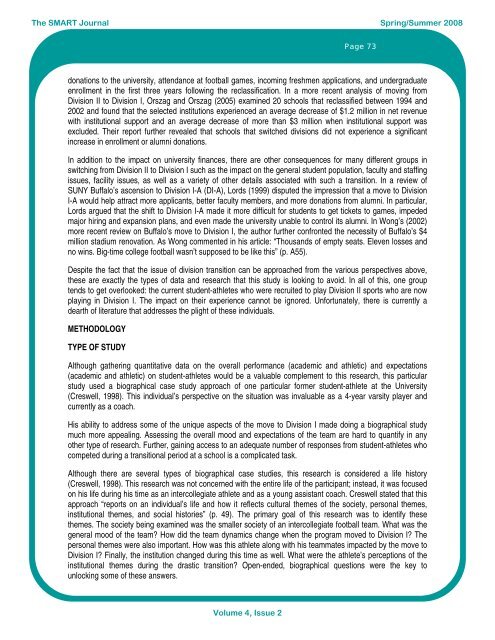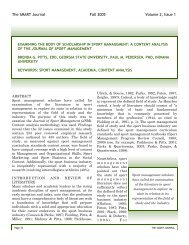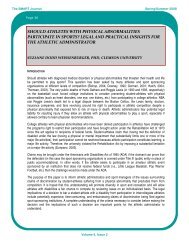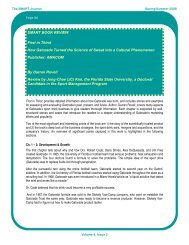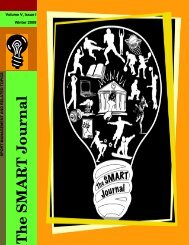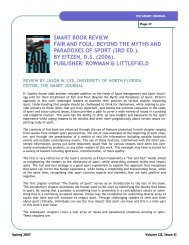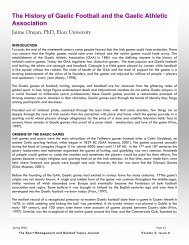Spring/Summer 2008 Volume 4, Issue 2 - The SMART Journal
Spring/Summer 2008 Volume 4, Issue 2 - The SMART Journal
Spring/Summer 2008 Volume 4, Issue 2 - The SMART Journal
You also want an ePaper? Increase the reach of your titles
YUMPU automatically turns print PDFs into web optimized ePapers that Google loves.
<strong>The</strong> <strong>SMART</strong> <strong>Journal</strong> <strong>Spring</strong>/<strong>Summer</strong> <strong>2008</strong><br />
Page 73<br />
donations to the university, attendance at football games, incoming freshmen applications, and undergraduate<br />
enrollment in the first three years following the reclassification. In a more recent analysis of moving from<br />
Division II to Division I, Orszag and Orszag (2005) examined 20 schools that reclassified between 1994 and<br />
2002 and found that the selected institutions experienced an average decrease of $1.2 million in net revenue<br />
with institutional support and an average decrease of more than $3 million when institutional support was<br />
excluded. <strong>The</strong>ir report further revealed that schools that switched divisions did not experience a significant<br />
increase in enrollment or alumni donations.<br />
In addition to the impact on university finances, there are other consequences for many different groups in<br />
switching from Division II to Division I such as the impact on the general student population, faculty and staffing<br />
issues, facility issues, as well as a variety of other details associated with such a transition. In a review of<br />
SUNY Buffalo’s ascension to Division I-A (DI-A), Lords (1999) disputed the impression that a move to Division<br />
I-A would help attract more applicants, better faculty members, and more donations from alumni. In particular,<br />
Lords argued that the shift to Division I-A made it more difficult for students to get tickets to games, impeded<br />
major hiring and expansion plans, and even made the university unable to control its alumni. In Wong’s (2002)<br />
more recent review on Buffalo’s move to Division I, the author further confronted the necessity of Buffalo’s $4<br />
million stadium renovation. As Wong commented in his article: “Thousands of empty seats. Eleven losses and<br />
no wins. Big-time college football wasn’t supposed to be like this” (p. A55).<br />
Despite the fact that the issue of division transition can be approached from the various perspectives above,<br />
these are exactly the types of data and research that this study is looking to avoid. In all of this, one group<br />
tends to get overlooked: the current student-athletes who were recruited to play Division II sports who are now<br />
playing in Division I. <strong>The</strong> impact on their experience cannot be ignored. Unfortunately, there is currently a<br />
dearth of literature that addresses the plight of these individuals.<br />
METHODOLOGY<br />
TYPE OF STUDY<br />
Although gathering quantitative data on the overall performance (academic and athletic) and expectations<br />
(academic and athletic) on student-athletes would be a valuable complement to this research, this particular<br />
study used a biographical case study approach of one particular former student-athlete at the University<br />
(Creswell, 1998). This individual’s perspective on the situation was invaluable as a 4-year varsity player and<br />
currently as a coach.<br />
His ability to address some of the unique aspects of the move to Division I made doing a biographical study<br />
much more appealing. Assessing the overall mood and expectations of the team are hard to quantify in any<br />
other type of research. Further, gaining access to an adequate number of responses from student-athletes who<br />
competed during a transitional period at a school is a complicated task.<br />
Although there are several types of biographical case studies, this research is considered a life history<br />
(Creswell, 1998). This research was not concerned with the entire life of the participant; instead, it was focused<br />
on his life during his time as an intercollegiate athlete and as a young assistant coach. Creswell stated that this<br />
approach “reports on an individual’s life and how it reflects cultural themes of the society, personal themes,<br />
institutional themes, and social histories” (p. 49). <strong>The</strong> primary goal of this research was to identify these<br />
themes. <strong>The</strong> society being examined was the smaller society of an intercollegiate football team. What was the<br />
general mood of the team? How did the team dynamics change when the program moved to Division I? <strong>The</strong><br />
personal themes were also important. How was this athlete along with his teammates impacted by the move to<br />
Division I? Finally, the institution changed during this time as well. What were the athlete’s perceptions of the<br />
institutional themes during the drastic transition? Open-ended, biographical questions were the key to<br />
unlocking some of these answers.<br />
<strong>Volume</strong> 4, <strong>Issue</strong> 2


